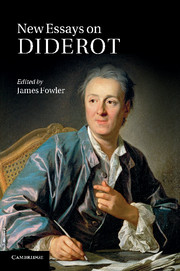Introduction
Published online by Cambridge University Press: 11 April 2011
Summary
Strictly speaking, there is only one kind of cause: the physical kind.
Diderot, Lettre à LandoisIn the Louvre hangs an attractive portrait of Diderot by Michel Van Loo. But how closely does it resemble the sitter? The philosophe writes amusingly that it is ‘too young, the head too small, as pretty as a woman, coquettish, smiling, dainty’. The problem, Diderot suggests, lay largely with himself: ‘whether it is because there are too many things blended together [in my face] or because the painter's eye sees it changing every instant (for the impressions of my soul succeed each other with great rapidity and they all paint themselves on my face), the artist's task becomes much more difficult than he thought it was’. In a word, it is very hard to take the likeness of such a face. Yet this is the metaphorical task collectively assumed by the contributors to these New Essays. The founding aim of this project was to capture the most characteristic aspects of this thinker who is extraordinarily mobile, but repeatedly returns to certain beliefs and concerns.
This Introduction is designed to provide thematic ‘entry points’ into the chapters, which in turn open up perspectives on the oeuvre. To organise the whole, it was decided that the following headings would be used: Diderot the philosophe; the novels; the dialogues; the plays and dramatic theory; music, performance and aesthetics. It will be useful to say a few words on each of these in turn.
- Type
- Chapter
- Information
- New Essays on Diderot , pp. 1 - 10Publisher: Cambridge University PressPrint publication year: 2011

